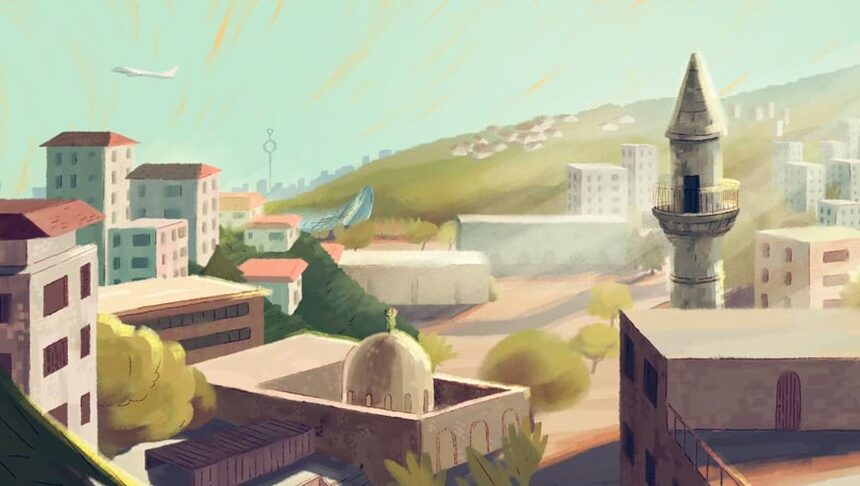|
Review by Daniel Lima In the West, the parameters of acceptable discourse on the subject of Israel and Palestine have been limited to simply acknowledging that there is a cycle of tumult and violence. The perception among the general public has been that interrogating why that is far too complicated, that assigning blame is a fruitless effort, and as a consequence, any solutions are far out of reach. After the past seven months of wanton destruction and killing by the Israeli government against the people of Palestine, that narrative is on the wane, and a situation that had been portrayed as prohibitively complex for decades has undergone a massive reevaluation. It is the perfect time for a film like Lyd, a work that draws a clear line between the sins of the past and our present reality and vociferously argues why contextualizing the present within that broader history is crucial in determining the future. Co-directed by American Sarah Ema Friedland and Palestinian Rami Younis, the film makes no qualms about its perspective: the colonization of the Levant in the aftermath of World War I by Western powers and the Israeli annexation of the city of Lyd represents an original sin that created deep wounds that have never and cannot ever heal so long as the subjugation of the Arab population remains the status quo. To that end, the film explores the city’s history via talking heads, narration, archival footage, and even animation, painting a portrait of a people under occupation and a world that could be different. The firsthand accounts of the Nakba, the 1948 ethnic cleansing of Palestinian families from land seized by Israel that saw thousands dead and hundreds of thousands expelled from their homes, are breathtaking. One man still living in the city recalls being forced as a child by the occupying forces to bury the bodies of those they killed, some so disfigured they had melted; a young man who has spent his entire life in a refugee camp mentions that his grandmother’s house is still standing and occupied by settlers, yet he is not even allowed to enter the city. Most chilling is a collection of testimonies from Israeli veterans, compiled by the IDF itself, where they remember what it was like shooting into building filled with men, women and children. One man, in particular, visibly disturbed, speaks of looking into the eyes of defenseless Palestinians and seeing himself as a murderer through them and how he was to them what generations of oppressors were to his people. Off-screen, someone derisively asks, “What, are you a pacifist now?” as if that is a bad thing. The man clams up. Taken with the contemporary Palestinian accounts, these interviews establish that the origins of this conflict are not ancient, not incomprehensible. They are the direct result of people and are still within living memory, so this conflict is not the hopeless quagmire we are so often told it is. There are some attempts to show what life is like for Arab Israelis, the fallout of the Nakba that continues to rain down. While these slice-of-life scenes serve that purpose, displaying in stark relief what life under oppression is like, there is a certain artifice that is hard to shake. Some moments, like the camera gliding behind a man as he walks through the streets of his ad hoc community, feel perfectly lived in. Then there’s a shot-reverse shot scene of him ordering food at a restaurant, and suddenly, the film has adopted narrative cinematic language in a way that makes it feel inorganic. Nowhere is this more pronounced than in the classroom scene, where a group of children are asked about their identity. Their teacher is brought to tears by the ignorance they display about what it means to be Palestinian, and it is indeed shocking to hear their responses, but that shock can only go so far when the scene is so composed.
That being said, the documentary does have several more fanciful elements that work to varying degrees. The narration is given from the perspective of the city itself, a flourish that lends the film a certain texture but little else. More notable are the animated sequences, glimpses into an alternate world in which the Levant was never colonized by Europe. Admittedly, the rosy vision of a pluralistic society that knows only peace can be seen as a bit fanciful, particularly considering the film does reference religious tensions before the First World war. As is made clear by the finale, however, it is by imagining what could have been and what could be that calcified ideas of how the world is can be shattered. That is the power of Lyd: it shatters assumptions that many may have, until very recently, held unchallenged about the lives of Palestinians under Israeli occupation. The image it presents is filled with pain and suffering, of people forced to see what was taken from them as a daily form of torture, yet it does not simply revel in that suffering. Instead, it diagnoses the root cause, puts a face to the perpetrators, and, in doing so, allows the possibility for justice and a better tomorrow. Lyd arrives in theaters April 26. Rating: 4/5
1 Comment
Denise McCann
4/29/2024 01:33:23 pm
Trying to find out where I can watch Lyd on UK...
Reply
Leave a Reply. |
Archives
May 2024
Authors
All
|
|
|
disappointment media
Dedicated to unique and diverse perspectives on cinema! |


